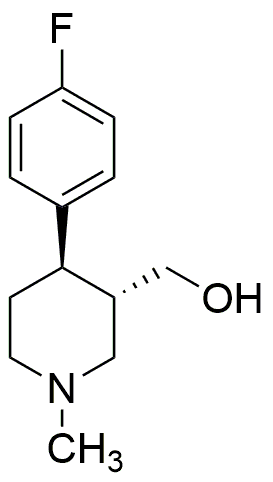(3S,4R)-4-(4-Fluorophenyl)-1-methyl-3-piperidinemethanol is widely utilized in research focused on:
- Pharmaceutical Development: This compound serves as a valuable intermediate in the synthesis of various pharmaceuticals, particularly in the development of drugs targeting neurological disorders.
- Neuroscience Research: It is used in studies exploring the mechanisms of action of neurotransmitters, helping researchers understand brain function and potential treatments for mental health conditions.
- Drug Formulation: The compound can be incorporated into formulations to enhance the bioavailability of active ingredients, making it beneficial in creating more effective medications.
- Analytical Chemistry: It acts as a standard reference material in analytical methods, aiding in the calibration of instruments and ensuring accurate measurements in research laboratories.
- Chemical Synthesis: The unique structure allows it to be a key building block in synthesizing other complex organic compounds, streamlining the development of new materials in various industries.
General Information
Properties
Safety and Regulations
Applications
(3S,4R)-4-(4-Fluorophenyl)-1-methyl-3-piperidinemethanol is widely utilized in research focused on:
- Pharmaceutical Development: This compound serves as a valuable intermediate in the synthesis of various pharmaceuticals, particularly in the development of drugs targeting neurological disorders.
- Neuroscience Research: It is used in studies exploring the mechanisms of action of neurotransmitters, helping researchers understand brain function and potential treatments for mental health conditions.
- Drug Formulation: The compound can be incorporated into formulations to enhance the bioavailability of active ingredients, making it beneficial in creating more effective medications.
- Analytical Chemistry: It acts as a standard reference material in analytical methods, aiding in the calibration of instruments and ensuring accurate measurements in research laboratories.
- Chemical Synthesis: The unique structure allows it to be a key building block in synthesizing other complex organic compounds, streamlining the development of new materials in various industries.
Documents
Safety Data Sheets (SDS)
The SDS provides comprehensive safety information on handling, storage, and disposal of the product.
Product Specification (PS)
The PS provides a comprehensive breakdown of the product’s properties, including chemical composition, physical state, purity, and storage requirements. It also details acceptable quality ranges and the product's intended applications.
Certificates of Analysis (COA)
Search for Certificates of Analysis (COA) by entering the products Lot Number. Lot and Batch Numbers can be found on a product’s label following the words ‘Lot’ or ‘Batch’.
*Catalog Number
*Lot Number
Certificates Of Origin (COO)
This COO confirms the country where the product was manufactured, and also details the materials and components used in it and whether it is derived from natural, synthetic, or other specific sources. This certificate may be required for customs, trade, and regulatory compliance.
*Catalog Number
*Lot Number
Safety Data Sheets (SDS)
The SDS provides comprehensive safety information on handling, storage, and disposal of the product.
DownloadProduct Specification (PS)
The PS provides a comprehensive breakdown of the product’s properties, including chemical composition, physical state, purity, and storage requirements. It also details acceptable quality ranges and the product's intended applications.
DownloadCertificates of Analysis (COA)
Search for Certificates of Analysis (COA) by entering the products Lot Number. Lot and Batch Numbers can be found on a product’s label following the words ‘Lot’ or ‘Batch’.
*Catalog Number
*Lot Number
Certificates Of Origin (COO)
This COO confirms the country where the product was manufactured, and also details the materials and components used in it and whether it is derived from natural, synthetic, or other specific sources. This certificate may be required for customs, trade, and regulatory compliance.


